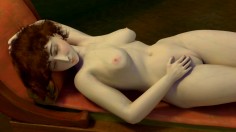CLAUDIA HART
Machina
source: claudiahart
Machina is a 3D animation portraying the compressed time and space of a painting. Her slow, drowsy movements articulate all of the minutia of a single moment. This projected “painting” is a representation that is primarily a persona. Based on the classical Odalisque and images of his wife by the Baroque artist Peter Paul Rubens, Machina consists of a series of animations that morph from painting to canonical painting. Arranged in random combinations on a time line, the resulting animation is sensual but without dramaturgy, evoking clockwork. Occasionally, Machina opens her eyes to gaze at the viewer, in a moment of transformation, allowing the object of our gaze to subject us to hers.
.
.
.
.
.
.
.
source: claudiahart
My work adapts the forms and software normally used to create 3d shooter games. It transposes discussions about digital technology and a critique of the media through a feminist lens. In the context of ideas about a technology that has replaced nature by threatening to eclipse and permanently alter it, I argue that contemporary ideas about technology are not a rupture but a reflection of very conventional ways of thinking.
Technological culture is still functionally an all-male engineering culture – what the historian of technology David Noble has identified as “a world without woman.” He describes the high-tech ethos as actually emerging from medieval Christian monasteries and describes it as still being driven by an unconscious millennial desire to recreate the world afresh, without women and outside of nature. I have experienced something similar on a personal level in the vocational schools where I taught 3D animation for eight years before coming to Chicago and the School of the Art Institute.
In the absence of women, the masculine culture of technology, colored by what Noble has connected to Christian Millennialism, defines the impulse behind much of technological development, from atomic weaponry and space exploration to cybernetics and robotics. This impulse is one of both annihilation and of purification. Equally religious values pervade the technological research of the military/entertainment complex and influences its visual manifestations, particularly in relation to the body. An example of this is the typically hyper-erotic femme fatale populating mass-culture representations.
By creating virtual images that are sensual but not pornographic within mechanized, clockwork depictions of the natural, I try to subvert earlier dichotomies of woman and nature pitted against a civilized, “scientific” and masculine world of technology. In my own way, I am staging a romantic rebellion against technocratic and bureaucratic culture.
.
.
.
.
.
.
.
source: eyebeamorg
Claudia Hart is an artist working with post photographic simulations technology to create media installations, objects and images. For the past fifteen years, she has used virtual imaging and 3D animation to create hyper-feminine, often erotic installations, sculptures and photo integrations that deal with issues of representation, the role of the computer in shifting values about identity and the real and what might be considered “natural.” Her works are polemical and meant to interject an emotional subjectivity into what is typically the aggressive, hardcore iconography adopted by the computer graphics industry.
Claudia Hart is represented by bitforms gallery, NY. She is a former IDMagazine as well as an Artforum editor and is an Associate Professor in the department of Film Video New Media and Animation at the School of theArt Institute of Chicago, where she developed a special program,“experimental 3D,” in which she developed new pedagogical structures for teaching computer animation in the context of the avant-garde and experimental film.


